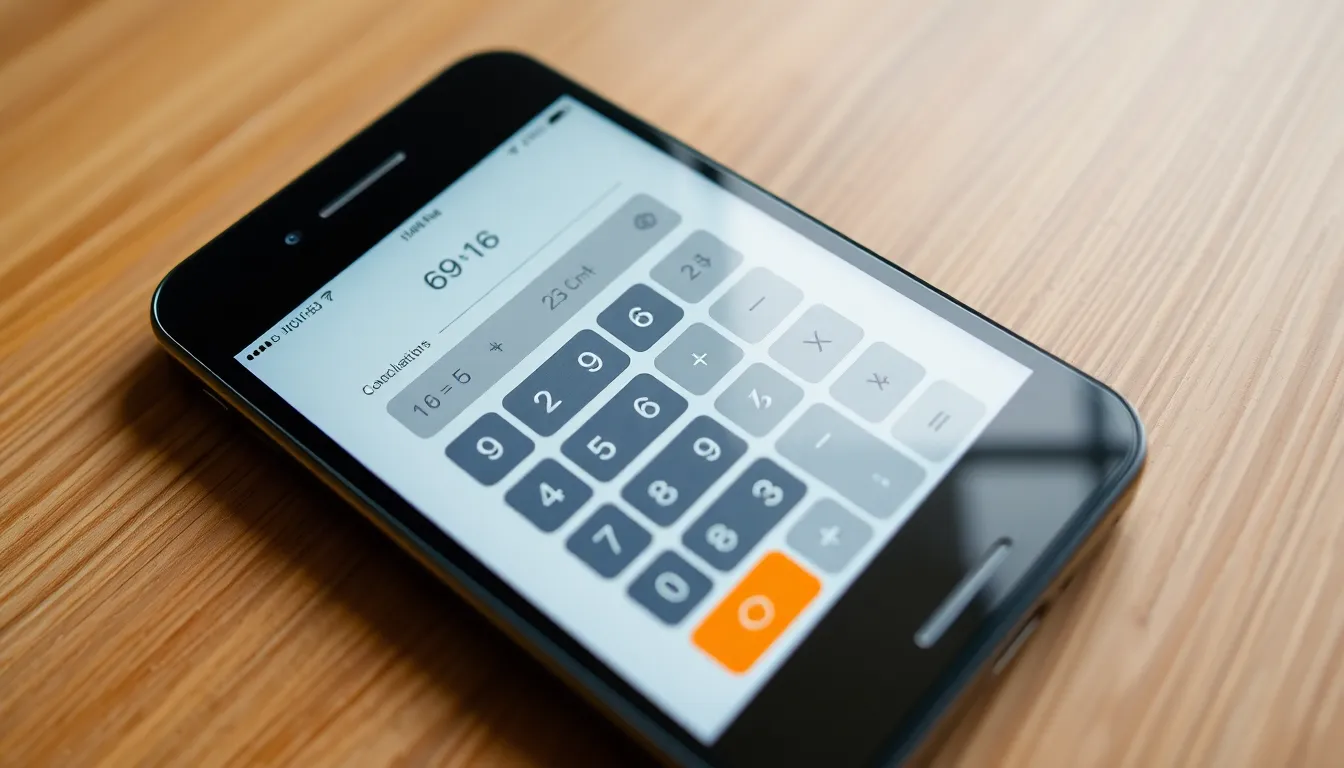Ever found yourself in a math pickle and wished your iPhone’s calculator had a rewind button? You’re not alone! Many users have experienced that moment of panic when they realize they’ve lost track of their calculations. Whether it’s figuring out the tip at a restaurant or crunching numbers for a DIY project, the struggle is real.
Table of Contents
ToggleUnderstanding Calculator History on iPhone
Calculator history on iPhone provides a way to track and revisit past calculations. While the built-in calculator does not display previous entries, users often find themselves wanting that functionality for convenience. It helps during tasks like splitting bills or estimating costs, making it a valuable feature.
Most users realize they can use screenshots as a workaround. Taking a screenshot saves the current screen, preserving calculations for later reference. Users can scroll up to see the previous inputs after performing new calculations, though oversight can occur if users forget to save their work.
Mistakes in calculations can happen frequently. Knowing there’s no direct history feature may encourage users to change their approach. He or she may start using notes or dedicated calculator apps with memory capabilities for a more efficient workflow. Those dedicated apps often allow users to store calculation history, making them easily accessible at any time.
Exploring options for third-party calculator apps can enhance the overall experience. Many apps offer features such as history logs, enhanced design, and additional functionality that the native app lacks. Users should feel empowered to explore these tools and customize their experience based on individual needs.
Remember, the built-in iPhone calculator serves basic functions well. For more complex tasks, leveraging alternative apps with robust history features can significantly improve usability. Users benefit from taking advantage of available resources to streamline their calculation processes.
Accessing Calculator History

Accessing calculator history on an iPhone can be challenging since the default calculator doesn’t store previous calculations. Many users find this limitation inconvenient, especially when needing to revisit past entries for tasks like splitting bills.
Locating the Calculator App
Finding the Calculator app on an iPhone is straightforward. Users can look for the app on the home screen or swipe down on the screen to use the search function. Typing “Calculator” will reveal the app quickly. This tool usually comes pre-installed on every iPhone, so it should be readily accessible.
How to Use the Calculator Function
To utilize the calculator function efficiently, users need to enter numbers and operations as needed. First, input the desired numbers, followed by the operation (addition, subtraction, multiplication, or division). Tapping “equals” will generate the result. For ongoing calculations, users can continue to add or subtract without starting over. Switching to landscape mode provides a scientific calculator with additional functions for more complex calculations, enhancing the user experience significantly.
Limitations of the Calculator History
The iPhone’s calculator lacks a built-in history feature. Users cannot view previous calculations, which poses challenges. Those performing multiple calculations, like splitting bills or estimating expenses, often find it frustrating.
While some users rely on screenshotting current calculations, this method isn’t foolproof. Forgetting to save or mistakenly deleting a screenshot can result in lost work. Many users experience anxiety over the inability to retrace steps.
Dedicated calculator apps address these limitations effectively. Alternative applications often include memory functions, enabling users to store and revisit past calculations. Utilizing these apps can minimize errors during lengthy calculations, especially in scenarios requiring accuracy.
Additionally, built-in notes apps provide simple alternatives for jotting down important figures. Users can combine calculator functions with notes for better organization. Employing both methods ensures that records remain intact and accessible.
Transitioning to third-party calculator solutions can significantly enhance the overall experience. Enhanced features cater to specific needs, such as scientific functions and complex operations. Searching for apps with robust history logs leads to well-rounded options that offer user-friendly interfaces.
For basic tasks, the built-in calculator may suffice; however, for users calculating consistently, exploring other applications is wise. Finding an optimal solution improves workflow and minimizes frustration. Concentrating on efficient tools can transform the way users handle numerical tasks on their devices.
Alternative Methods to Track Calculator Usage
Tracking calculations on an iPhone’s calculator can be challenging. Users often explore various alternatives to manage their tasks effectively.
Using Notes for Calculations
Notes apps serve as a practical solution for recording calculations. Users can jot down figures and equations alongside their calculations, ensuring easy access. By integrating notes with calculator functions, it becomes simpler to organize important information. The flexibility of the Notes app allows users to create lists or tables for clarity. Utilizing this method also enables users to save thoughts or adjustments related to calculations. Regularly employed, notes can enhance productivity and minimize confusion.
Third-Party Calculator Apps
Third-party calculator apps offer features that significantly improve the calculation experience. Many of these apps include memory functions and history logs, allowing users to track previous calculations effortlessly. Customization options often differentiate these apps from the built-in version, providing tailored user experiences. In addition, some apps support advanced functions, making them suitable for complex mathematical tasks. Users frequently find that dedicated apps increase efficiency during workflows involving substantial numbers. Exploring these calculator alternatives can drastically streamline the calculation process on iPhones.
Finding a way to manage calculations on an iPhone can be challenging. Users often feel frustrated when they can’t access previous entries in the built-in calculator. While taking screenshots can be a temporary solution, it isn’t always reliable.
Exploring dedicated calculator apps with memory functions can significantly enhance the user experience. These apps not only allow users to store and revisit calculations but also provide additional features that cater to various needs.
For those who prefer a simpler method, utilizing notes apps can help keep important figures organized. By adopting these alternatives, users can streamline their calculations and reduce stress, making numerical tasks more manageable on their devices.


